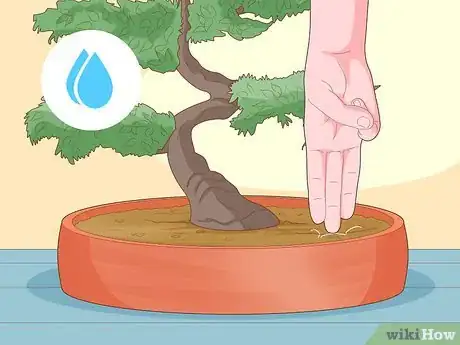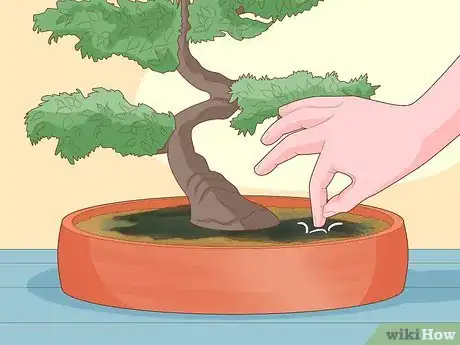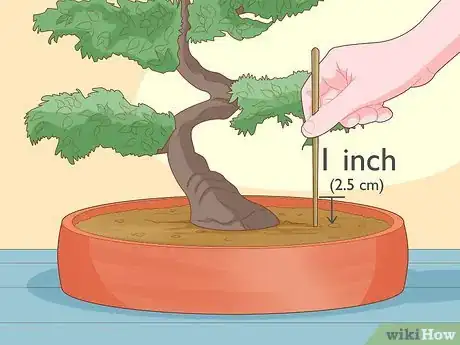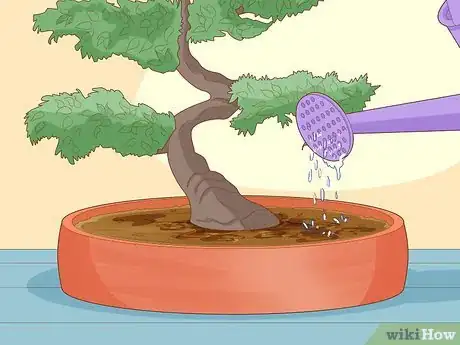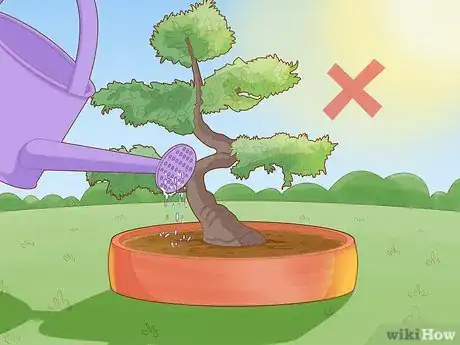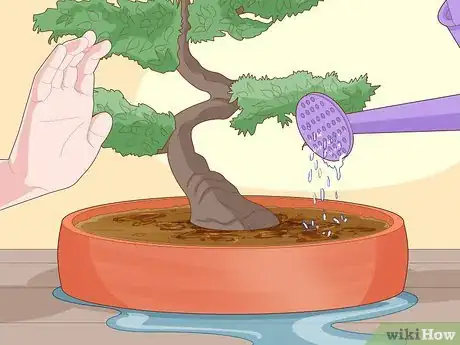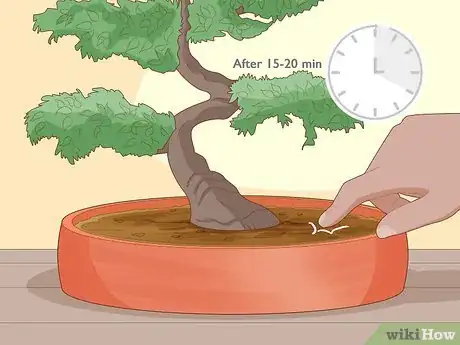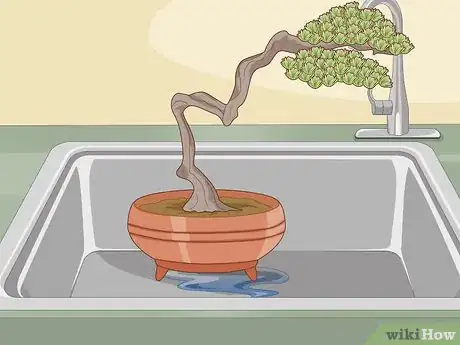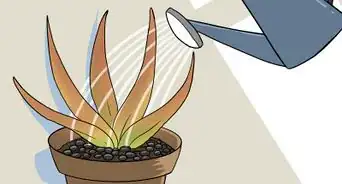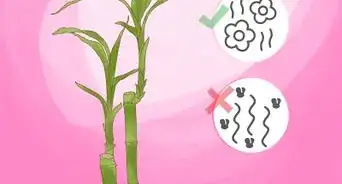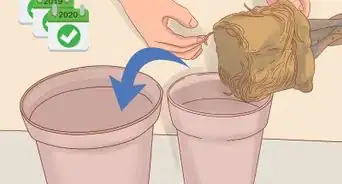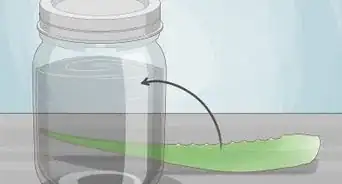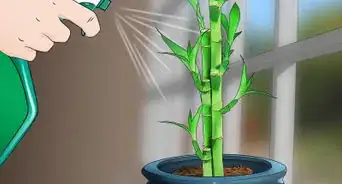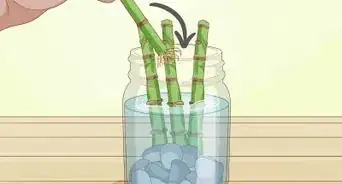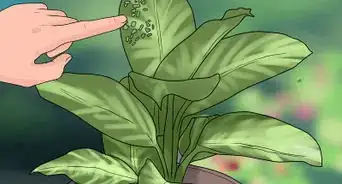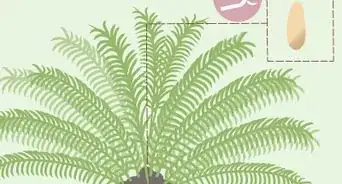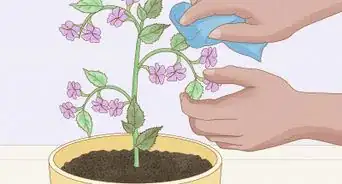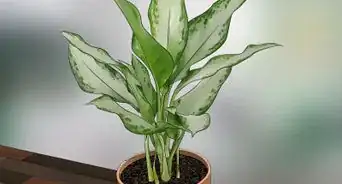This article was co-authored by wikiHow Staff. Our trained team of editors and researchers validate articles for accuracy and comprehensiveness. wikiHow's Content Management Team carefully monitors the work from our editorial staff to ensure that each article is backed by trusted research and meets our high quality standards.
There are 9 references cited in this article, which can be found at the bottom of the page.
This article has been viewed 14,277 times.
Learn more...
Watering a bonsai tree can be tricky because they're thirsty plants that don't have a set watering schedule. Checking the soil every day is going to give you an idea of your bonsai tree’s needs. Since bonsai soil isn’t like regular potting soil, how you water it makes a difference. You may need to do 2 or 3 top-waterings in a single watering session so it can fully soak in. If your bonsai is small, you can also soak it in a tub of water for 5 to 10 minutes whenever the soil feels dry.
Steps
Monitoring Moisture Levels
-
1Feel the top of the soil with your fingers to check dryness. Place 2 to 3 fingers at the base of the bonsai tree, just around where the trunk enters the soil. If it feels damp, there's no need to water it. Otherwise, it's too dry and is in need of water.[1]
- If the soil on the sides of the planter feels dry but the soil near the trunk is damp, don’t water it and check it again in about 8 to 12 hours.
-
2Inspect the top layer of soil for a grayish color. Bonsai soil is made from a mix of crushed substrates like lava rock, peat, and brick—it looks more like gravel than dirt. When it's time to water, this top layer will appear extra loose and dull-gray in color.[2]
- Bonsai trees won't grow well in regular potting soil because the thick, rich soil holds too much water and may cause root rot.
Advertisement -
3Use a wooden chopstick as a moisture gauge. Hold the chopstick by the thicker end and insert the narrow end 1 inch (2.5 cm) into the soil. Pull it out to check the water line before every day or touch it to your inner wrist or cheek to feel for moisture.[3]
- Reinsert the chopstick into the soil at least 3 inches (7.6 cm) away from the trunk of the tree so it’s ready to check the next day.
- Use a clean wooden or bamboo chopstick—this won’t work with ceramic or plastic chopsticks.
- Don't stick the chopstick into the soil any deeper than 1 in (2.5 cm) because doing so might disturb the root system.
- Some store-bought bonsai trees come with small wooden posts for this very reason.
Top-Watering a Bonsai Tree
-
1Fill a rose-spout watering tin with 2 cups (470 mL) of water. A rose-spout has lots of tiny holes in it to ensure the water comes out gently so the pressure from the water doesn’t disturb the soil. It will also make watering easier because the rose-spout covers a wider area than a mono-spout.[4]
- You can buy a rose-spout watering can or rose attachment at most garden supply stores.
- You can also attach a rose cap to a garden hose for outdoor bonsai trees.
- If it’s hot outside and your bonsai is outdoors, make sure to use room temperature water to avoid shocking the root system.
-
2Pour water over the tree until you see puddles on the top of the soil. Gently pour water out of the rose spout onto the soil. Move the spout around to moisten the entire surface of the soil. Slowly watering the tree will give the water time to soak into the soil and slowly travel downwards.[5]
- If you're using a rose attachment on a garden hose, point the cap upwards so the water travels in an arc and lands gently on the bonsai soil.
-
3Don’t water the leaves if your bonsai is in full sun on a hot day. It’s generally okay to get the leaves wet. However, on hot days, any water droplets that get on the leaves can magnify the light rays and burn the leaves. If you live in an area that gets very hot during the day, avoid splashing the leaves with the water.[6]
- As an alternative, keep the bonsai in a shaded area during the summer so you don’t have to worry about scorching the leaves.
-
4Stop watering when you see puddles forming or water draining from the base. It should take about 30 seconds to fully saturate the soil. Water coming out of the drainage holes is a good indicator that the soil is nice and moist.[7]
- The water coming out of the bottom of the planter should be clear, not brown or gray. If it's brown or gray, water it again in 15 to 20 minutes.
-
5Wait 15 to 20 minutes before watering it again if necessary. If the top layer of soil feels dry already or if your bonsai needs a little extra love, pour another helping of water over the soil. The idea is to fully saturate the soil but not so much that it stays sopping wet, so stop watering as soon as you see water dripping out of the bottom.[8]
- If you notice yellowing leaves or shriveling branches, skip the second watering because these are signs of oxygen deprivation due to too much water.
- If your bonsai tree has crispy leaves, do a third 30-second watering or revive it in a water bath.
Immersing a Small Bonsai Tree
-
1Fill a large tub or container with 2 inches (5.1 cm) of water. Choose a tub that's big enough to fit the bonsai planter into it and deep enough to hold 2 inches (5.1 cm) of water. Make sure the container is clean before filling it with water.[9]
- This is only necessary if your bonsai shows signs of dehydration like crispy, wilting leaves.
-
2Place the bonsai upright into the center of the tub. Make sure the water doesn’t spill over the top sides of the planter. The idea is that the water will travel from the bottom to the top of the soil through the drainage holes.[10]
- If the bonsai tree is in a light, plastic container, it may float at first. Press and hold it down until it stays in place.
-
3Check the soil for dampness after 5 to 10 minutes. You'll know the soil at the top of the container is moist when it darkens in color. If you're not sure, feel it with your fingers. If it's adequately moist, the soil will feel wet and give a little under your finger.[11]
- If the soil feels dry and doesn't leave a depression when you press it down, leave it in the water for another 5 minutes and then check it again.
-
4Place the bonsai in the sink or on an outdoor table so it can drain. The water needs to drain out of the bonsai after the soak, so put it somewhere you don’t mind getting wet. An outdoor patio or bench is a good spot.[12]
- You can also place the bonsai on a drainage tray if you keep the plant indoors. Just be sure to check on and, if necessary, empty the shallow tray after 15 to 20 minutes so water doesn't overflow.
Expert Q&A
-
QuestionHow much water does a bonsai need per day?
 Melinda MeservyMelinda Meservy is a Plant Specialist and the Owner of Thyme and Place, a botanical boutique offering plants and gifts in Salt Lake City, Utah. Before starting her own business, Melinda worked in process and business improvement and data analytics. Melinda earned a BA in History from the University of Utah, is trained in lean and agile methodologies, and completed her Certified Professional Facilitator certification. Thyme and Place offers indoor plants and containers, a fully stocked potting bench, and tips on plants to suit your space and lifestyle.
Melinda MeservyMelinda Meservy is a Plant Specialist and the Owner of Thyme and Place, a botanical boutique offering plants and gifts in Salt Lake City, Utah. Before starting her own business, Melinda worked in process and business improvement and data analytics. Melinda earned a BA in History from the University of Utah, is trained in lean and agile methodologies, and completed her Certified Professional Facilitator certification. Thyme and Place offers indoor plants and containers, a fully stocked potting bench, and tips on plants to suit your space and lifestyle.
Plant Specialist It totally depends on the specific species of the bonsai, its size, its soil, and the humidity in the area. It's going to be totally variable, which is part of what makes cultivating and caring for bonsais so interesting for a lot of people! Each bonsai has its own little personality, so it's hard to give concrete recommendations on this. It depends on your specific bonsai.
It totally depends on the specific species of the bonsai, its size, its soil, and the humidity in the area. It's going to be totally variable, which is part of what makes cultivating and caring for bonsais so interesting for a lot of people! Each bonsai has its own little personality, so it's hard to give concrete recommendations on this. It depends on your specific bonsai. -
QuestionHow do you stunt a bonsai if it's overgrowing?
 Melinda MeservyMelinda Meservy is a Plant Specialist and the Owner of Thyme and Place, a botanical boutique offering plants and gifts in Salt Lake City, Utah. Before starting her own business, Melinda worked in process and business improvement and data analytics. Melinda earned a BA in History from the University of Utah, is trained in lean and agile methodologies, and completed her Certified Professional Facilitator certification. Thyme and Place offers indoor plants and containers, a fully stocked potting bench, and tips on plants to suit your space and lifestyle.
Melinda MeservyMelinda Meservy is a Plant Specialist and the Owner of Thyme and Place, a botanical boutique offering plants and gifts in Salt Lake City, Utah. Before starting her own business, Melinda worked in process and business improvement and data analytics. Melinda earned a BA in History from the University of Utah, is trained in lean and agile methodologies, and completed her Certified Professional Facilitator certification. Thyme and Place offers indoor plants and containers, a fully stocked potting bench, and tips on plants to suit your space and lifestyle.
Plant Specialist You cut and prune a portion of the plant to stunt that area. This is also how you control the direction and shape of the plant. Just make sure that you don't overdo it or you'll end up stunting the entire plant.
You cut and prune a portion of the plant to stunt that area. This is also how you control the direction and shape of the plant. Just make sure that you don't overdo it or you'll end up stunting the entire plant.
Warnings
- Sago palm, jade, azalea, cherry, fig, plum, and Norfolk pine bonsai trees are toxic to pets.[16]⧼thumbs_response⧽
Things You'll Need
Monitoring Moisture Levels
- Wooden chopstick (optional)
Top-Watering a Bonsai Tree
- Rose-spout watering can or hose attachment
Immersing a Small Bonsai
- Large tub
- Drainage tray (optional)
References
- ↑ https://www.pubs.ext.vt.edu/content/dam/pubs_ext_vt_edu/426/426-601/426-601_pdf.pdf
- ↑ https://www.pubs.ext.vt.edu/content/dam/pubs_ext_vt_edu/426/426-601/426-601_pdf.pdf
- ↑ https://bonsailearningcenter.com/2016/11/watering/
- ↑ https://bonsailearningcenter.com/2016/11/watering/
- ↑ https://youtu.be/rgpYcxCAGeY?t=19
- ↑ https://aggie-horticulture.tamu.edu/syllabi/302/new/topic/bonsai.htm
- ↑ https://youtu.be/rgpYcxCAGeY?t=19
- ↑ https://youtu.be/i0okyL_biR8?t=150
- ↑ https://sites.psu.edu/forloveofchlorophyll/2017/11/17/bonsai-general-care/
- ↑ https://youtu.be/AIt8piVt3P8?t=170
- ↑ https://youtu.be/AIt8piVt3P8?t=180
- ↑ https://www.pubs.ext.vt.edu/content/dam/pubs_ext_vt_edu/426/426-601/426-601_pdf.pdf
- ↑ https://www.pubs.ext.vt.edu/content/dam/pubs_ext_vt_edu/426/426-601/426-601_pdf.pdf
- ↑ https://www.pubs.ext.vt.edu/content/dam/pubs_ext_vt_edu/426/426-601/426-601_pdf.pdf
- ↑ https://sites.psu.edu/forloveofchlorophyll/2017/11/17/bonsai-general-care/
- ↑ https://bonsaitutor.com/are-bonsai-trees-poisonous-to-cats-with-6-examples/
